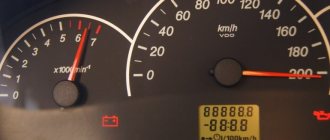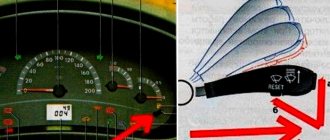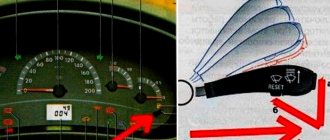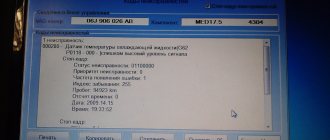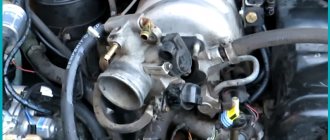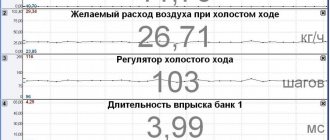Where is the diagnostic connector located on a Chevrolet Niva?
The classic location of the diagnostic connector block in most cars is behind the steering wheel near the ignition switch . Chevy Niva is no exception. The OBD type pinout is used. On-board diagnostics of the first generation was developed back in 1991 with the purpose of reading information on the state of the ECU (electronic control unit). This system is responsible for all engine functions.
The first copies of Niva Chevrolet used a 12-pin OBD1 connector . Since 2002, it was changed to 16-pin OBD2. To select the correct diagnostic equipment for the on-board computer, you need to find out in advance what type of pinout is in a particular Chevrolet Niva.
On topic: error code 8 on a Chevrolet Niva
Niva Chevrolet phase sensor died: we diagnose ECM, panel self-diagnosis
Interesting facts about cars Uncategorized
© Repair a car yourself - video repair lessons
Copying materials from a web resource without the consent of the site administration is strictly prohibited.
Every modern car owner knows about the existence of an on-board computer, which can not only indicate the basic parameters of the operating mode (speed, consumption, temperature), but also recognize errors caused by various malfunctions. Unfortunately, Chevrolet Niva error codes cannot be deciphered without additional tables, since there are too many of them. Let's consider various diagnostic methods.
We receive the first signal about the presence of a malfunction using the indicator on the “Check-Engene” panel.
After turning on the ignition, all systems are tested, and if no errors are detected, this indicator goes out. Otherwise it remains burning. Specialized centers will quickly identify the error and not for free, but the Chevrolet Niva has a built-in on-board computer that can allow you to deal with the problem yourself.
OBD 1 pinout
To correct the operation of electronic systems, OBD equipment was invented. The first generation pinout has a rectangular shape with 12 pins.
Each element of the nest has its own purpose:
- pin A transmits mass information;
- B corresponds to the diagnostic L-line;
- D—CO potentiometer;
- contact G is responsible for the fuel pump control functions;
- H—food;
- M - K-Line diagnostics.
At the bottom of the pinout there is a “Key” , which is responsible for maintaining the correct design of the equipment. This element is designed to ensure the correct orientation of the plug and connector in the car.
Car brands and years of manufacture
Any injection model before 2002 has an OBD1 pinout. When determining the type of diagnostic connector for 2002 cars, it is worth considering that some may already use OBD2. They can be easily distinguished by their “rosette” shape .
Diagnostics and fault codes of the Chevrolet Niva Niva ECM with controller ME17.9.71
The presence of a malfunction is indicated by the on-board diagnostic system by turning on the warning light.
The on-board diagnostic system must then use special equipment to obtain diagnostic information stored in the controller's memory.
For this purpose, a serial information transmission channel is organized in the engine control system, which includes an ECM controller, a standardized block for connecting a diagnostic device (Fig. 1) and a wire connecting them (K-line). In addition to the block, the information transfer protocol and the format of transmitted messages are also standardized.
The main component of the on-board diagnostic system is the ECM. In addition to its main task (controlling the combustion processes of the fuel mixture), it performs self-diagnosis.
When performing this function, the controller monitors signals from various sensors and actuators of the ECM. These signals are compared with reference values stored in the controller's memory. If any signal goes outside the control values, the controller evaluates this condition as a malfunction (for example, the voltage at the sensor output has become zero - short circuit to ground), generates and records the corresponding diagnostic information in the error memory, and turns on the warning lamp (alarm) indicates malfunctions, and also switches to emergency operating modes of the ECM.
1) Diagnostics of sensors. The controller, by monitoring the value of the sensor output signal, determines the presence or absence of a malfunction.
2) Diagnostics of ECM actuators (driver diagnostics). The controller checks the control circuits for opens, shorts to ground, or shorts to the power supply.
3) Diagnostics of ECM subsystems (functional diagnostics).
In the engine control system, several subsystems can be distinguished - ignition, fuel supply, idle speed maintenance, exhaust gas neutralization, gasoline vapor recovery, etc.
Functional diagnostics gives an opinion about the quality of their work. In this case, the system no longer monitors individual sensors or actuators, but the parameters that characterize the operation of the entire subsystem as a whole.
For example, the quality of operation of the ignition subsystem can be judged by the presence of misfires in the combustion chambers of the engine. Fuel adaptation parameters provide information about the state of the fuel supply subsystem. Each subsystem has its own requirements regarding the maximum permissible deviations of its parameters from the average values.
The fault indicator on Chevrolet Niva cars is located in the instrument cluster.
When the warning light comes on, it means that the on-board diagnostic system has detected a malfunction of the ECM and the vehicle continues to move in emergency mode.
A flashing warning light indicates a malfunction that can lead to serious damage to the ECM (for example, misfires can damage the catalytic converter).
When the ignition is turned on, the indicator should light up - this way the ECM checks the serviceability of the indicator and its control circuit. After starting the engine, the indicator should go out if the controller memory does not contain the conditions for turning it on.
To protect against random, short-term errors that may be caused by loss of contact in electrical connectors or unstable engine operation, the warning light turns on after a certain period of time after detecting a malfunction in the ECM. During this period, the on-board diagnostic system checks for a malfunction.
After eliminating the causes of the malfunction, the alarm will turn off after a certain delay time, during which the malfunction does not appear, and provided that there are no other fault codes in the controller’s memory that require turning on the alarm.
2. DIAGNOSTICS OF THE EURO-2 ENGINE CONTROL SYSTEM NIVA CHEVROLET
Section 2 - “Diagnostics” consists of the following parts:
General information
Information about the diagnostic procedure, safety measures and the DST-2M diagnostic device. A description of the electrical connections of the engine control system and the pin assignments of the controller connector are also provided.
Part “A” and diagnostic cards “A”
Contains initial information on diagnostic procedures, including “DIAGNOSTIC CIRCUIT CHECK,” diagnostic charts for the fault warning light, troubleshooting procedures in case of failure to start the engine, and other general charts.
Fault code cards
These cards are used if, when checking the diagnostic circuit, a fault code stored in the controller’s memory is detected. If there is more than one code, analysis and troubleshooting must always begin with codes P0560 (incorrect mains voltage) or P0562 (low mains voltage).
OBD 2 pinout
The 12-pin OBD1 in the Chevrolet Niva has been replaced by OBD2 . This is due to the introduction of new standards in Europe since 2001. This solution has significantly expanded the possibilities of car diagnostics.
The first copies of the equipment showed general error information. Using OBD2, the car owner can independently obtain complete information on the state of the ECU by using a scanning device or adapter. 16-pin connector. Its shape has changed: now it is a trapezoid with a narrowing downwards.
The plug contacts are responsible for the following diagnostic elements:
- pin 2 - bus+ (via J1850);
- 4 — body grounding;
- 5 - signal grounding;
- 6 - CAN-High line (via J-2284 protocol);
- 7 - K-Line;
- 10 — bus- (via J1850);
- 14 - CAN-Low line (via J-2284 protocol);
- 15 — L-line;
- 16 - battery powered.
Car brands and years of manufacture
OBDII has been used in cars since 1996 in the USA. In Europe, standards changed in 2001. In the Chevrolet Niva, new diagnostic connectors first appeared in the 2002-2019 models . These cars work with control systems BOSCH MP7.0 Euro-3, BOSCH M7.9.7, January-7.2, January-7.3.
Access and location
The location remains unchanged : at the ignition switch. OBDII is partially hidden behind the steering wheel cover.
Car diagnostics
Diagnostics of the engine and other systems and units in Chevrolet Niva, Cobalt, Lacetti, Lanos, Captiva, Cruze, Aveo 2004, 2005, 2010, 2012 and other model years allows you to timely identify the fault. Thanks to this, the car owner can prevent more serious damage. The errors themselves when diagnosing with a laptop or on a VDO display or other factory dashboard will be different. During self-diagnosis on the on-board computer State on the instrument panel of a VAZ 2123 or Chevrolet Tahoe, Orlando, Blazer, Lanos, Niva, Lacetti, Cruz, Captiva, Epica, Aveo in the T250 and T300 body, faults are displayed in two-digit form. Instead of combinations, messages may appear on the display to warn motorists.
Pressing the odometer button on the dashboard
There are two ways to check for errors in a Chevrolet: self-diagnosis or using additional equipment or a computer. In order for the on-board computer to test for faults, you need to hold down the button on the odometer to reset the daily mileage and turn the key in the ignition.
Diagnostic connector pins for used protocols
The OBDII standard suggests the possibility of using 5 diagnostic protocols . Chevrolet Niva uses 3 of them:
- J1850 PWM. High-speed protocol with a performance of 41.6 Kb/sec. Transmits signals via pins 2, 4, 5, 10, 16.
- J1850 VPW. (The principle) of transmitting signals via pins 2, 4, 5, 16 is the same, but the speed is 10.4 Mb/s.
- ISO 9141-2. The simplest protocol that does not require complex communication microprocesses (unlike the above). Performs pulse transmission using pins 4, 5, 7, 15, 16
Features: The ISO 9141-2 protocol is easy to determine, thanks to pin 7, as well as the exclusion of pin 2 (10) on the Chevy Niva diagnostic connector.
If the system does not have pin 7, the SAE J1850 VPW (Variable Pulse Width Modulation or Pulse Width Modulation) protocol is used. The specified signal transmission protocols function properly via a standard OBD-II J1962 connector cable.
Diagnostics with a scanner
The information in this section is quite extensive, since there are many types of scanners.
The basic principle of their operation is that all data, including errors, is transmitted from the ECU to a special diagnostic connector, which in a Chevrolet Niva is located on the driver's side under the steering wheel.
The scanner's job is to read and decode these messages.
Note that there are dealer scanners, that is, those that are designed for a given car. For Chevrolet Niva this is BC State.
It is inserted into the panel instead of the signaling device, and the information loop is prepared from the factory.
Selecting equipment for diagnosing Niva Chevrolet
The first step when choosing a cable for reading information from an on-board computer is determining the type of connector.
The main difference between OBDI and OBDII (besides the year of manufacture of the vehicle in which it is installed) is the shape of the connector. How to determine what type of pinout is used in a particular car is described in detail above. It is also possible to connect the K-Line connector to the OBD connector on the Niva Chevrolet. In this way, special diagnostic equipment is installed.
To read information from the OCU you will need:
- a scanning device that supports the required type of connections (currently, in addition to traditional equipment operating via a USB cable, there are items that support wi-fi and bluetooth functions);
- laptop;
- adapter (if necessary);
- appropriate software for diagnostics (for the Russian automotive industry, the ScanMaster ELM 2.1 and OpenDiagPro programs are recommended).
Important! The computer must support the same types of information transfer as the adapter. Otherwise, connection will not be possible.
There is a wide range of diagnostic equipment on the modern market . It is divided into the following types:
- "amateur" equipment;
- multi-brand (multifunctional) devices;
- professional equipment.
The last two categories are used for work at service stations and dealerships . For self-diagnosis, it is enough to purchase a simple adapter for beginners based on the ELM327 chip.
Even the most minimally functional equipment is capable of performing all basic tasks (detecting an error, correcting it, transmitting information about the state of the ECU to the PC screen). Such a service in service centers costs up to 1,500 rubles. Purchasing an adapter will save the Niva owner from the need to contact specialists and save money.
Carefully! There are cases when the controller generates an error even though it is fully operational. The reason is the failure of the scanning device itself.
Self-diagnosis
The function involves shutting down the system in which the breakdown occurred, followed by enabling a bypass program .
A "Check Engine" light on the dashboard should worry the owner of a Chevrolet Niva. The developers have provided a standard self-diagnosis function. This option is useful in cases where there is a short-term failure in the program, but the machine continues to operate as normal. You can identify an “accident” using self-diagnosis.
Chevrolet Niva error diagnosis
The most reliable way to identify what is wrong with a car is to diagnose electrical appliances and equipment. The procedure allows you to accurately identify breakdowns and quickly repair your car.
There are two ways to detect a problem in a car.
Self-diagnosis VAZ 2123
The simplest procedure allows the motorist to independently identify the damaged area and repair the damage. Thanks to the successful firmware of the on-board computer, some errors are displayed on the standard display. In this case, nothing happens on its own - you will need to perform several steps manually:
If the manipulations are correct, one of the indicated codes will appear on the display, and each Niva Chevrolet error number will be responsible for its own section of the highway:
At the same time, you need to accurately understand that, for example, when error 10 is on the display, the Chevrolet Niva tells the driver that there are several problems (standard, unambiguous codes are summed up).
You should also know that Niva Chevrolet self-diagnosis errors do not reflect the exact location of the breakdown. Codings can only show the section of the wiring where you need to look for the cause of the malfunction. Also, these encryptions may be the result of a software failure after an unsuccessful wash or disconnection of the battery. To obtain more accurate data, the user needs to connect a special diagnostic scanner.
Computer diagnostics
The most complete diagnosis is possible with a computer or laptop. In order to use this method, you must purchase an adapter. This adapter performs two functions at once. It is an adapter from a K-line port to a USB port or to a COM port. It also acts as a decoder, which allows you to transmit signals from the ECU to the PC. You will also need to install the appropriate software on your laptop. There are a lot of free versions on the Internet. There are universal programs, as well as programs written for a specific car. After connecting to the computer, you will need to turn on the ignition and launch the program. The connection will happen automatically.
The interface of the computer program is very convenient and allows even an inexperienced user to navigate intuitively. All functionality can be divided into several sections. These are parameters, errors and settings. If the first two sections are informational, then using the third section you can control the vehicle systems.
Few people know that the Chevrolet Niva has a self-diagnosis function that produces basic error codes that can be used to quickly find and fix vehicle problems. It is not difficult to carry out this procedure yourself; just press the odometer button firmly and turn on the ignition at the same time. The arrows on the speedometer will creep up, after pressing again, an information message about the firmware version will be displayed, and the next time, all error codes will appear on the monitor, naturally, if there are malfunctions in the car.

